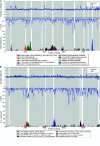Clinical, histopathologic and molecular features of idiopathic and diabetic nodular mesangial sclerosis in humans
- PMID: 33537765
- PMCID: PMC8826640
- DOI: 10.1093/ndt/gfaa331
Clinical, histopathologic and molecular features of idiopathic and diabetic nodular mesangial sclerosis in humans
Abstract
Background: Idiopathic nodular mesangial sclerosis, also called idiopathic nodular glomerulosclerosis (ING), is a rare clinical entity with an unclear pathogenesis. The hallmark of this disease is the presence of nodular mesangial sclerosis on histology without clinical evidence of diabetes mellitus or other predisposing diagnoses. To achieve insights into its pathogenesis, we queried the clinical, histopathologic and transcriptomic features of ING and nodular diabetic nephropathy (DN).
Methods: All renal biopsy reports accessioned at Indiana University Health from 2001 to 2016 were reviewed to identify 48 ING cases. Clinical and histopathologic features were compared between individuals with ING and DN (n = 751). Glomeruli of ING (n = 5), DN (n = 18) and reference (REF) nephrectomy (n = 9) samples were isolated by laser microdissection and RNA was sequenced. Immunohistochemistry of proline-rich 36 (PRR36) protein was performed.
Results: ING subjects were frequently hypertensive (95.8%) with a smoking history (66.7%). ING subjects were older, had lower proteinuria and had less hyaline arteriolosclerosis than DN subjects. Butanoate metabolism was an enriched pathway in ING samples compared with either REF or DN samples. The top differentially expressed gene, PRR36, had increased expression in glomeruli 248-fold [false discovery rate (FDR) P = 5.93 × 10-6] compared with the REF and increased 109-fold (FDR P = 1.85 × 10-6) compared with DN samples. Immunohistochemistry revealed a reduced proportion of cells with perinuclear reaction in ING samples as compared to DN.
Conclusions: Despite similar clinical and histopathologic characteristics in ING and DN, the uncovered transcriptomic signature suggests that ING has distinct molecular features from nodular DN. Further study is warranted to understand these relationships.
Keywords: PRR36; diabetic nephropathy; laser microdissection; nodule; transcriptomics.
© The Author(s) 2021. Published by Oxford University Press on behalf of ERA-EDTA. All rights reserved.
Figures







References
-
- Alpers CE, Biava CG. Idiopathic lobular glomerulonephritis (nodular mesangial sclerosis): a distinct diagnostic entity. Clin Nephrol 1989; 32: 68–74 - PubMed
-
- Herzenberg AM, Holden JK, Singh S et al. . Idiopathic nodular glomerulosclerosis. Am J Kidney Dis 1999; 34: 560–564 - PubMed
-
- Markowitz GS, Lin J, Valeri AM et al. . Idiopathic nodular glomerulosclerosis is a distinct clinicopathologic entity linked to hypertension and smoking. Hum Pathol 2002; 33: 826–835 - PubMed
-
- Wu J, Yu S, Tejwani V et al. . Idiopathic nodular glomerulosclerosis in Chinese patients: a clinicopathologic study of 20 cases. Clin Exp Nephrol 2014; 18: 865–875 - PubMed
-
- Li W, Verani RR. Idiopathic nodular glomerulosclerosis: a clinicopathologic study of 15 cases. Hum Pathol 2008; 39: 1771–1776 - PubMed
Publication types
MeSH terms
Grants and funding
LinkOut - more resources
Full Text Sources
Other Literature Sources
Medical
Molecular Biology Databases

